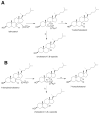Intersection of the Roles of Cytochrome P450 Enzymes with Xenobiotic and Endogenous Substrates: Relevance to Toxicity and Drug Interactions
- PMID: 27472660
- PMCID: PMC5293730
- DOI: 10.1021/acs.chemrestox.6b00226
Intersection of the Roles of Cytochrome P450 Enzymes with Xenobiotic and Endogenous Substrates: Relevance to Toxicity and Drug Interactions
Abstract
Today much is known about cytochrome P450 (P450) enzymes and their catalytic specificity, but the range of reactions catalyzed by each still continues to surprise. Historically, P450s had been considered to be involved in either the metabolism of xenobiotics or endogenous chemicals, in the former case playing a generally protective role and in the latter case a defined physiological role. However, the line of demarcation is sometimes blurred. It is difficult to be completely specific in drug design, and some P450s involved in the metabolism of steroids and vitamins can be off-targets. In a number of cases, drugs have been developed that act on some of those P450s as primary targets, e.g., steroid aromatase inhibitors. Several of the P450s involved in the metabolism of endogenous substrates are less specific than once thought and oxidize several related structures. Some of the P450s that primarily oxidize endogenous chemicals have been shown to oxidize xenobiotic chemicals, even in a bioactivation mode.
Conflict of interest statement
The author declares no competing financial interests, although he is involved in consulting for several pharmaceutical companies.
Figures






References
-
- Mueller GC, Miller JA. The metabolism of 4-dimethylaminoazobenzene by rat liver homogenates. J Biol Chem. 1948;176:535–544. - PubMed
-
- Miller EC, Miller JA. Mechanisms of chemical carcinogenesis: nature of proximate carcinogens and interactions with macromolecules. Pharamcol Rev. 1966;18:805–838. - PubMed
-
- Gillette JR, Brodie BB, La Du BN. The oxidation of drugs by liver microsomes: on the role of TPNH and oxygen. J Pharmacol Exp Ther. 1957;119:532–540. - PubMed
-
- Axelrod J. The enzymatic deamination of amphetamine. J Biol Chem. 1955;214:753–763. - PubMed
-
- Ryan KJ. Biological aromatization of steroids. J Biol Chem. 1959;234:268–272. - PubMed
Publication types
MeSH terms
Substances
Grants and funding
LinkOut - more resources
Full Text Sources
Other Literature Sources

